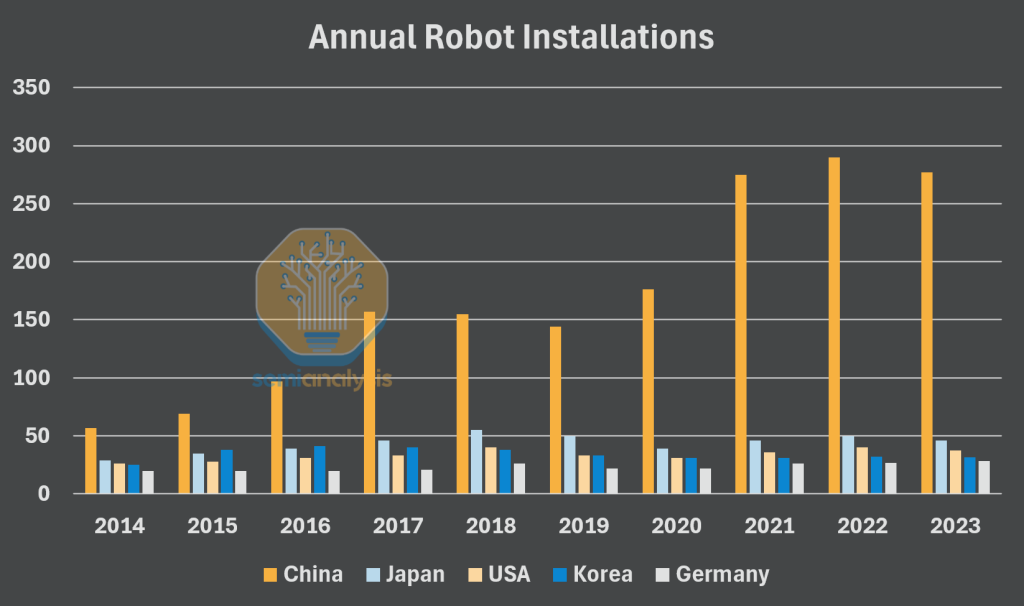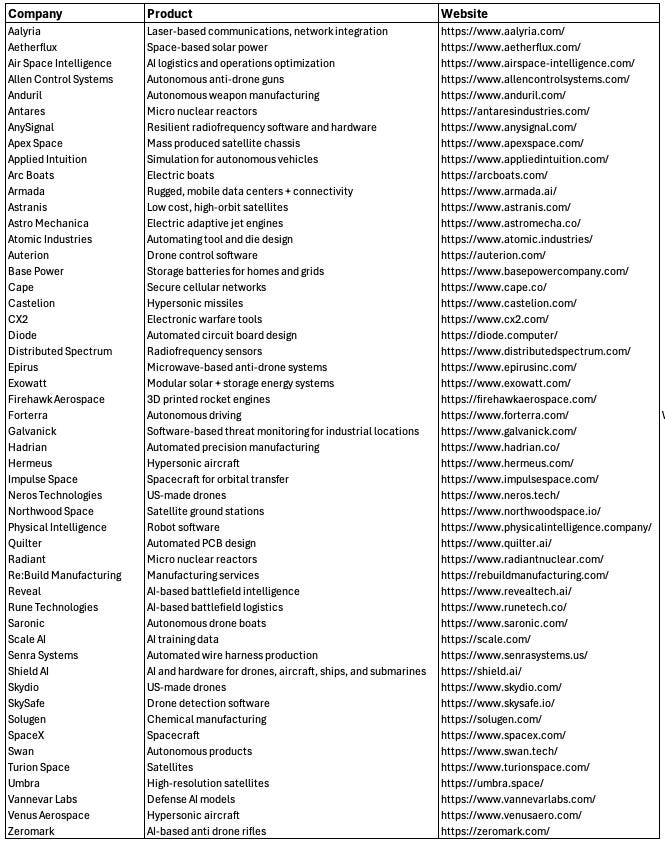Reading List 03/15/25
Chinese EUV machines, North Korea’s nuclear submarine, greenhouse gas and low-orbit satellites, far-UVC for pandemic prevention, and more.

Welcome to the reading list, a weekly roundup of news and links on buildings, infrastructure, and industrial technology. This week we look at Chinese EUV machines, North Korea’s nuclear submarine, greenhouse gas and low-orbit satellites, far-UVC for pandemic prevention, and more. Roughly 2/3rds of reading list content is paywalled, so for full access become a paid subscriber.
No essay this week, but I’m working on a more involved piece about solar energy that will be out next week.
Semi Analysis on robots
Semi Analysis has a very long analysis of the robotics landscape, and how China is poised to dominate it. China is installing far more robots than other countries, and those robots are increasingly Chinese-made at low cost. As AI makes robotics more and more capable, dominating their production will become more and more valuable:
This is a Call for Action for the United States of America and the West. We are in the early precipice of a nonlinear transformation in industrial society, but the bedrock the US is standing on is shaky. Automation and robotics is currently undergoing a revolution that will enable full-scale automation of all manufacturing and mission-critical industries. These intelligent robotics systems will be the first ever additional industrial piece that is not supplemental but fully additive– 24/7 labor with higher throughput than any human—, allowing for massive expansion in production capacities past adding another human unit of work. The only country that is positioned to capture this level of automation is currently China, and should China achieve it without the US following suit, the production expansion will be granted only to China, posing an existential threat to the US as it is outcompeted in all capacities…
While Chinese manufacturers are currently on par with Western giants in the low-end market, our supply chain review leads us to believe that local firms are beginning to take over the higher-end market segments. The rise of Unitree exemplifies this shift: the only viable humanoid robot on the market, the Unitree G1, is now entirely decoupled from American components…
While the revenues of the major companies are much larger than those of China, the landscape has been shifting toward western sleeping giants growing complacent and Chinese innovation. Chinese robotics are picking up very quickly through companies like Estun, Efort, and Siasun, and their recent takeovers of the aforementioned European robotics companies.
These companies are setting up to be powerhouses. Most are focused on strong vertical integration, like Estun with up to 95% of core components manufactured in-house, enabling them to rapidly iterate product development. They recognize the power of a strong production capacity, for example EFORT is planning to build out a “Super Plant” to upgrade production capacity by 100,000 robots/year. Siasun is already well-equipped for an impressive production output with around 2.3M square footage of factories globally. Furthermore, their R&D numbers may speak for themselves, but Siasun has gone even further in their innovation strategy. The company went so far as to buy a leading German mechanical engineering vocational school so that they could both train new employees abroad and gain access to the decades of German experience in training engineers, all while setting up its own robotics institute at a Chinese university.
Chinese EUV machines
In other “Chinese technological progress” news, the most advanced semiconductors require extreme ultraviolet (EUV) lithography machines, which etch semiconductor features using extremely small wavelength ultraviolet light, generated by vaporizing microscopic drops of molten tin. These machines are only built by one company, ASML in the Netherlands. ASML currently does not export these machines to China, but China is apparently making progress on its own EUV technology. From TechPowerup, via the Register:
China's domestic extreme ultraviolet (EUV) lithography development is far from a distant dream. The newest system, now undergoing testing at Huawei's Dongguan facility, leverages laser-induced discharge plasma (LDP) technology, representing a potentially disruptive approach to EUV light generation…This methodology offers several technical advantages over ASML's laser-produced plasma (LPP) technique, including simplified architecture, reduced footprint, improved energy efficiency, and potentially lower production costs.
A16z’s American Dynamism 50
Venture Capital fund Andressen Horowitz (colloquially known as a16z) has for the last several years been trumpeting it’s support of “American Dynamism”: funding companies that “support the national interest: aerospace, defense, public safety, education, housing, supply chain, industrials, and manufacturing.” They recently released a list of their “American Dynamism 50”, 50 companies that aim to “fortify the U.S. against the threats an Indo-Pacific crisis would unleash, from securing self-sustaining supply chains to building AI-powered defense systems and resilient energy infrastructure.”
For convenience, I’ve listed all the companies and what they do in one single table:
It’s interesting to see what made the cut. There’s lots of “automate/use AI for task X”-type companies: AI for battlefield logistics, for tool and die design, for circuit board design, for wire harnesses, for precision parts, for anti-drone weapons, and so on. Related, there’s also lots of drone-related companies, either building drones, software for controlling drones, or defense against drones. There’s also lots of companies offering various satellite services. Satellites for space-based solar power, satellites for high-resolution imaging, mass-produced satellite chassis, and so on.
It’s also somewhat heartening to see how many of these companies are doing hardware, and not simply trying to sell software services to someone else doing the hardware (though there is plenty of that too.) Hadrian isn’t just automating other people’s processes, they’re operating their own automated factories; Senra is actually making wire harnesses rather than just selling software to other people making them, and so on.
Fusion instabilities
I’ve written several thousand words about fusion energy, so I have some understanding of what makes it so difficult and the problems that need to be overcome to build a working fusion reactor. But because I don’t have a physics background, this understanding is ultimately sort of shallow: I don’t truly understand the challenges of fusion the way, say, a physicist would. So I’m always ready to learn more from folks who actually understand the physics involved.
In that vein, I enjoyed this extended analogy for why confining the plasma in a fusion reactor is so hard:
Consider the diagram on the right of Figure 1. I have drawn some ripples on the surface of the water. Air pressure provides a force perpendicular to the water surface which means that around the ripples we no longer have a force pointing straight up. The force points partly sideways and this serves to deform the shape of the water surface. But as the water surface becomes even more deformed the forces become even more distorted away from vertical causing a feedback loop. So we can expect even the tiniest of ripples to grow to the point where the water completely changes shape and it eventually deforms its way out of the glass.
This is an example of an instability - in this case it's called the Rayleigh-Taylor instability. And this suggests an approach to keeping water in an inverted cup - suppress the ripples…
[For fusion,] we can't simply use a solid container to hold the plasma as no container can survive such temperatures. Instead we need some other confinement method such as magnetic confinement, where we use magnetic fields to control the plasma, or inertial confinement where we use explosions around the fuel to drive the fuel into a small volume. Both of these suffer from the same problem: we're using a force to control a fluid and this is subject to instabilities. Confining a plasma is like trying to keep water in an inverted cup by blowing on the water with fans. It's really hard. What's more, plasma has incredibly complex dynamics that is subject to many different kinds of instability. Around fifty named instabilities are listed on Wikipedia.




